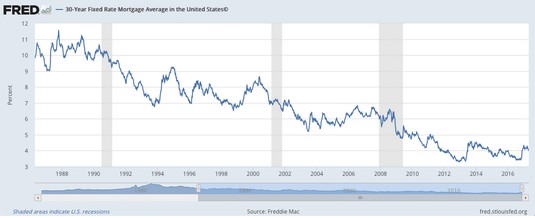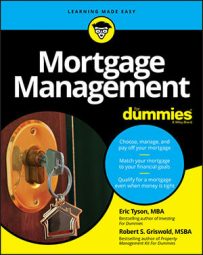This image illustrates how 30-year fixed-rate mortgage interest rates have fluctuated over the years. You can bet with 100 percent certainty that they’ll continue to bounce up and down due to ever-changing economic conditions. However, once you have your very own 30-year fixed-rate loan, its interest rate won’t ever change.
 © Freddie Mac. Used with permission.
© Freddie Mac. Used with permission.A long-term perspective on 30-year fixed-rate mortgage interest rates.
Because the interest rate doesn’t vary with a fixed-rate mortgage, the advantage of a fixed-rate mortgage is that you always know what your monthly payment is going to be. Thus, budgeting and planning the rest of your personal finances is easier.
That’s the good news. The bad news is that with a fixed-rate mortgage, you pay a premium, in the form of a higher interest rate, to get a lender to commit to lending you money at a fixed rate over the full term of the mortgage. The longer the term for which a mortgage lender agrees to accept a fixed interest rate, the more risk that lender is taking.
In addition to paying a premium interest rate when you originally get a fixed-rate loan, another potential drawback to fixed-rate loans is that, if interest rates fall significantly after you have your mortgage, you face the risk of being stuck with your costly mortgage. That could happen if, for example, due to problems with your personal financial situation or a decline in the value of your property, you don’t qualify to refinance. Even if you do qualify to refinance, doing so takes time and costs money (appraisal, loan fees, and title insurance).
Here are a couple of other possible drawbacks to be aware of with some fixed-rate mortgages:
- Fixed-rate mortgages aren’t generally assumable, so if you sell during a period of high interest rates, your buyers must obtain their own financing. Finding assumable ARMs, however, is difficult.
- As with some adjustable-rate mortgages, some fixed-rate mortgages have prepayment penalties.

